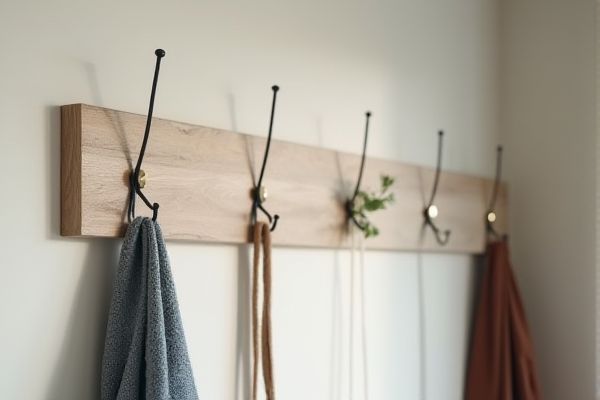
Wall hooks provide fixed support points ideal for organizing items or hanging equipment within easy reach, while ceiling hoists offer versatile lifting solutions that maximize floor space and enhance mobility. Explore the full article to discover which option best suits Your needs for safety and convenience.
Table of Comparison
| Feature | Wall Hooks | Ceiling Hoists |
|---|---|---|
| Installation | Mounted on walls, requires studs for support | Mounted on ceiling structures, requires secure beams |
| Load Capacity | Typically up to 50 lbs (22.7 kg) | Supports heavy loads, often up to 600 lbs (272 kg) |
| Usage | Ideal for hanging light items like coats, bags | Used for lifting patients or heavy equipment |
| Space Efficiency | Consumes wall space; may clutter area | Free floor and wall space; overhead operation |
| Durability | Usually metal or plastic; moderate durability | Heavy-duty materials; built for long-term use |
| Cost | Low cost, generally under $20 | Higher cost, ranging $500 to $2,000+ |
| Safety | Safe for light loads; minimal risk | Strict safety standards; essential for assisted lifting |
Introduction to Wall Hooks and Ceiling Hoists
Wall hooks provide a simple and cost-effective solution for organizing and hanging items on walls, ideal for maximizing vertical space. Ceiling hoists offer more advanced lifting and support capabilities, often used in medical or industrial settings to safely transfer or lift heavy loads. Your choice depends on the weight, mobility needs, and installation environment for optimal efficiency.
Key Differences Between Wall Hooks and Ceiling Hoists
Wall hooks are fixed devices mounted on walls designed for lightweight lifting and securing items, offering easy accessibility and space-saving benefits. Ceiling hoists, installed on overhead tracks or beams, provide superior weight capacity and mobility, allowing for efficient vertical and horizontal transport of heavy loads in industrial and medical settings. The primary differences lie in load capacity, installation requirements, and operational flexibility, making ceiling hoists suitable for heavier, more complex lifting tasks compared to the simpler, stationary function of wall hooks.
Common Applications for Wall Hooks
Wall hooks are commonly used for organizing and hanging objects like coats, bags, and kitchen utensils in residential and commercial spaces. In contrast to ceiling hoists, which are designed for lifting heavy equipment or assisting mobility-impaired individuals, wall hooks provide accessible and space-saving storage solutions. Their versatility makes wall hooks ideal for use in entryways, bathrooms, garages, and retail displays.
Typical Uses for Ceiling Hoists
Ceiling hoists are predominantly used in healthcare settings to assist patients with limited mobility, enabling safe transfers between beds, wheelchairs, and bathrooms. They are crucial in rehabilitation centers, hospitals, and home care environments for lifting and moving individuals without causing strain to caregivers. These devices improve safety, reduce injury risks, and enhance the efficiency of patient handling.
Space and Installation Requirements
Wall hooks require minimal space and straightforward installation, making them ideal for small rooms or areas with solid walls capable of supporting weight. Ceiling hoists demand more complex installation, involving ceiling reinforcement and clearance for overhead movement, best suited for spacious environments with structural support. Choosing between them hinges on available room dimensions and the feasibility of secure mounting points.
Load Capacity and Safety Considerations
Wall hooks typically offer moderate load capacities suitable for lighter equipment or personal use, while ceiling hoists are engineered for higher load capacities, often exceeding several hundred kilograms, making them ideal for heavy lifting tasks. Ceiling hoists incorporate advanced safety features like locking mechanisms, emergency stop functions, and load sensors to prevent overloading and accidents, whereas wall hooks rely primarily on secure installation and material strength. Your choice should prioritize not only the required load capacity but also the safety protocols inherent to each system to ensure reliable and secure operation.
Cost Comparison: Wall Hooks vs Ceiling Hoists
Wall hooks offer a more cost-effective solution with lower initial installation expenses, typically ranging from $20 to $50 per unit, making them ideal for budget-conscious setups. Ceiling hoists involve higher upfront costs, often between $1,000 and $3,000 depending on the model and installation complexity, but provide enhanced mobility and safety for heavy lifting tasks. Maintenance and operational costs are also generally higher for ceiling hoists due to mechanical components requiring regular servicing, whereas wall hooks involve minimal upkeep.
Pros and Cons of Wall Hooks
Wall hooks offer a simple, cost-effective solution for hanging items with easy installation and minimal space usage, making them ideal for small rooms or lightweight objects. However, they have limited weight capacity and may cause damage to walls if overloaded or improperly installed, reducing their durability compared to ceiling hoists. Your choice depends on the specific lifting needs, where wall hooks suit lighter storage or hanging while ceiling hoists are better for heavy-duty lifting and mobility.
Advantages and Disadvantages of Ceiling Hoists
Ceiling hoists offer superior mobility and increased safety for transferring individuals, reducing caregiver strain and minimizing the risk of injury compared to wall hooks. They require professional installation and higher initial costs, which may be prohibitive for some users, but their ability to move across multiple rooms provides unmatched convenience. Maintenance and space requirements can also pose challenges, yet their long-term benefits in accessibility and support make them a preferred choice in many care settings.
How to Choose: Wall Hooks or Ceiling Hoists for Your Needs
Choosing between wall hooks and ceiling hoists depends on the available space, weight capacity, and mobility requirements. Wall hooks are ideal for fixed lifting tasks in limited spaces and are easier to install, while ceiling hoists offer greater lift range and flexibility for larger rooms or therapy areas. Consider the specific load weight, installation feasibility, and the intended use environment to ensure the most efficient and safe lifting solution.
 homyna.com
homyna.com